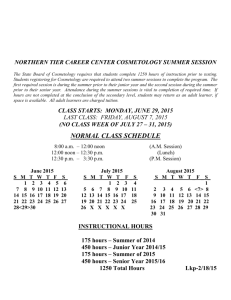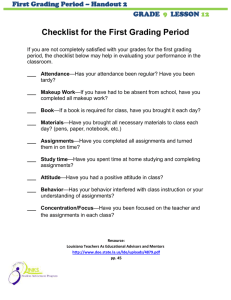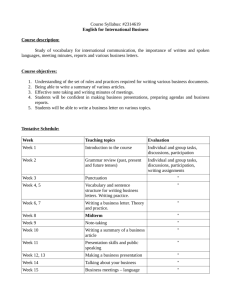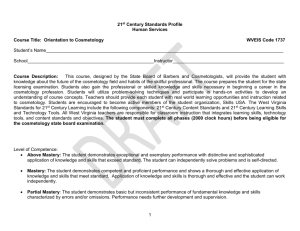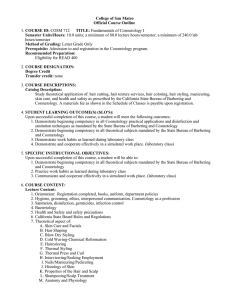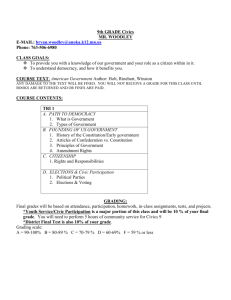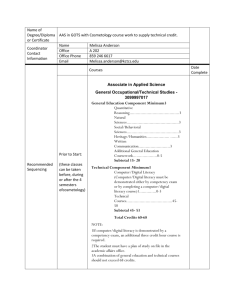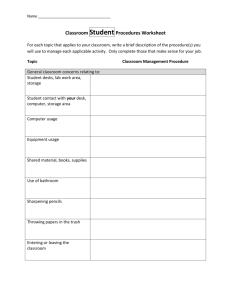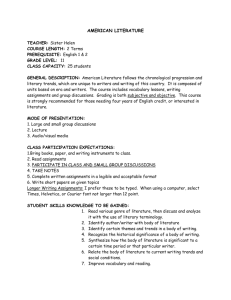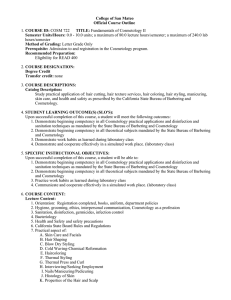SYLLABUS FOR Esthetician - Caddo Kiowa Technology Center
advertisement
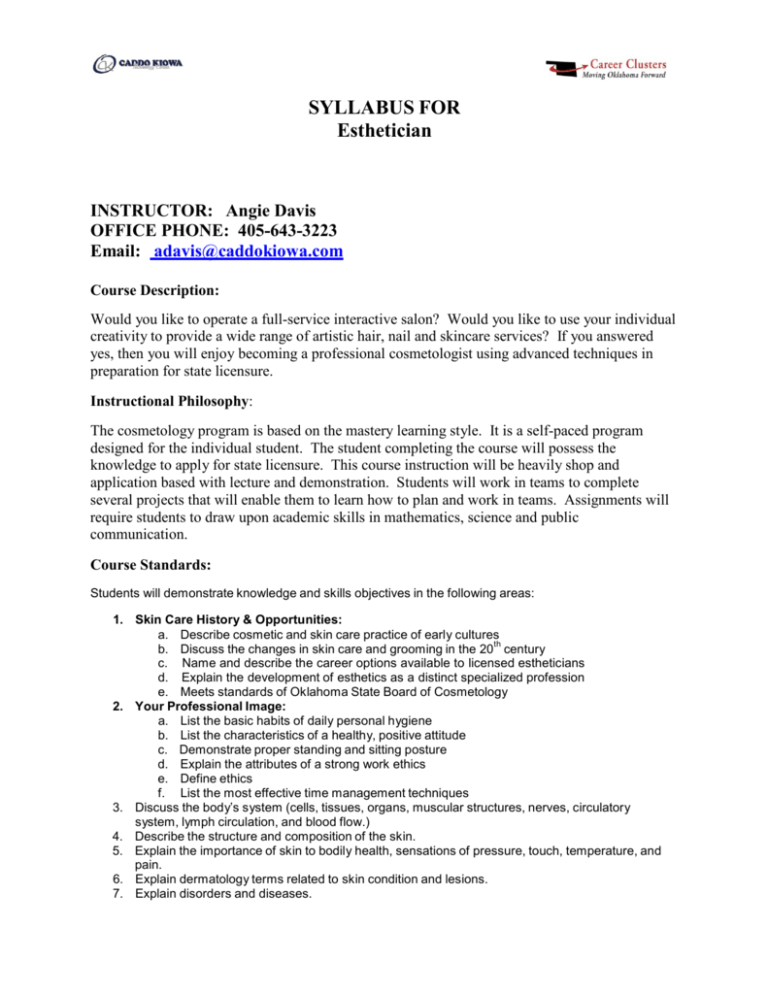
SYLLABUS FOR Esthetician INSTRUCTOR: Angie Davis OFFICE PHONE: 405-643-3223 Email: adavis@caddokiowa.com Course Description: Would you like to operate a full-service interactive salon? Would you like to use your individual creativity to provide a wide range of artistic hair, nail and skincare services? If you answered yes, then you will enjoy becoming a professional cosmetologist using advanced techniques in preparation for state licensure. Instructional Philosophy: The cosmetology program is based on the mastery learning style. It is a self-paced program designed for the individual student. The student completing the course will possess the knowledge to apply for state licensure. This course instruction will be heavily shop and application based with lecture and demonstration. Students will work in teams to complete several projects that will enable them to learn how to plan and work in teams. Assignments will require students to draw upon academic skills in mathematics, science and public communication. Course Standards: Students will demonstrate knowledge and skills objectives in the following areas: 1. Skin Care History & Opportunities: a. Describe cosmetic and skin care practice of early cultures th b. Discuss the changes in skin care and grooming in the 20 century c. Name and describe the career options available to licensed estheticians d. Explain the development of esthetics as a distinct specialized profession e. Meets standards of Oklahoma State Board of Cosmetology 2. Your Professional Image: a. List the basic habits of daily personal hygiene b. List the characteristics of a healthy, positive attitude c. Demonstrate proper standing and sitting posture d. Explain the attributes of a strong work ethics e. Define ethics f. List the most effective time management techniques 3. Discuss the body’s system (cells, tissues, organs, muscular structures, nerves, circulatory system, lymph circulation, and blood flow.) 4. Describe the structure and composition of the skin. 5. Explain the importance of skin to bodily health, sensations of pressure, touch, temperature, and pain. 6. Explain dermatology terms related to skin condition and lesions. 7. Explain disorders and diseases. 8. Literacy: Read, comprehend and synthesize information from a wide range of sources within the Cosmetology field. Write and speak clearly using the language of the field to communicate effectively of audiences. • Books • Web Pages • Journals • Technical Manuals 9. Numeracy: demonstrate mathematical reasoning and numeracy skills, mathematic procedures and an understanding of major mathematical concepts that underline the career field. 10. Science: Apply an understanding of scientific principles in the cosmetology field. 11. 21st Century Skills: Critical Thinking, work in teams to effectively complete projects, Problem Solving, Initiative, Self-direction, Prioritize, plan and manage work to achieve intended results, Productively & Accountability. Job Description: Be able to endure long hours standing on your feet. Social Skills Have an aesthetic sense Career Ready Certificates • • There will be a competency test at the end of instruction consisting of 60 multiple choice questions. This test will be given in the student services testing lab. A state competency certificate will be given when the student passes with 70% or higher. Students are expected to work toward Work Keys certification. Students will participate in Career Ready 101 through the student services testing center. Opportunities for Advanced Learning • Students willing to go above and beyond classroom expectations may request advanced learning opportunities from their instructor. Major Projects and Assignments: 1. Demonstrate good grooming principles 2. Your Professional Image: a. Demonstrate proper standing and sitting posture 3. Demonstrate the lifting of blackheads and whiteheads. Weekly Grading Method: Each week the student will receive a weekly grade. The purpose of the weekly grade is to determine and develop the student’s attitude toward the world of work. A dependable employee would be expected to be at work on tike prepared to perform daily tasks to the best of their ability. Unexcused absences and class tardiness will result in a lowering of the weekly grade. Each week’s grade is worth 100 points which is broken down into the following scale: □Accountability □Critical Thinking √ I Was On Time √ I Came Prepared √ Limit Absences √ Analyze Information and Elements of Problems □Initiative/Self Direction √ Completed all Homework Assignments on Time □Problem Solving √ Demonstrated Commitment to Learning □Collaboration/Teamwork √ Worked Well with Fellow Students □Leadership √ Professional Dress √ Professional Behavior □Productivity √ No Cell Phone Use During Class □Cooperation √ Participated in Class Discussion and Class Procedures □Communication √ Complete All Written Assignments/Lab-Shop Activities □Job Skills √ I Am More Prepared Today Than Yesterday for Future Employment Distribution of Grading Components Grades are determined by dividing the points earned by the total number of points possible for each grade category. Each category is a percentage of the total points for the grading period as follows: Journals/Lab 50% Test 50% Description of Grading and Quality Work A 90-100% Consistently demonstrates an advanced level of quality. Shows mastery in evaluating, synthesizing and applying the appropriate applications to solve the problem at hand. ALL components of the work are complete. B 80-89% Consistently demonstrates an above average level of quality. Characterized by analysis and application of the problem at hand. Most (80% or more) of the components of the work are complete. C 70-79% Demonstrates proficient level of quality. Shows recognition and comprehension of the problem at hand. Some (70-79%) of the components of the work are complete. D 60-69% Demonstrates a basic level of quality. Shows limited understanding or comprehension of application software. Several (60%) of the work may not be incomplete or poor quality. F Below 60% Demonstrates a below basic level of quality. Shows little or no understanding or comprehension of problem at hand. Many (below 60%) components of the work may be complete or poor quality. Redo/Rework Policy Student assessment will be based on group work, individual completion of laboratory projects and test of student’s knowledge. If necessary, students will be given more than one opportunity to complete assignments to meet course standards. Late or Missing Work Make up work will be on a case by case basis after discussion with instructor. Extra Help Extra help can be received in the classroom if request by student or may be suggested by teacher. Students making a C or lower will have a plan of action for improvement. Parents will be involved in the improvement process. Behavior All students are to do their own work. When using other’s material, proper credit will be given. Students are expected to treat others and their classroom equipment with respect. Attendance Policy CKTC is committed to providing the knowledge and skills training which prepares our students for both entering the workplace and continuing their education. Class attendance is essential for students to realize their fullest potential from their educational efforts. Students who are habitually absent or arrive late will miss the heart of the course and will not be prepared for the workplace or college. For successful career major completion, students must be in attendance ninety percent (90%) of his/her scheduled hours per semester. Violation of the attendance policy will result in suspension from school for the balance of the semester. This policy applies to both high school and adult students enrolled in career majors at CKTC, unless the Board of Education has designated a more stringent attendance policy for a specific career major due to the educational requirements of that specific career field. Three times tardy equals one absence. Arriving more than 30 minutes late is an absence; leaving more than 30 minutes early is an absence. Pathway to Career/Further Study Ready After completing this career major, students may enter the workforce in an entry level position. The next step for further study will be Workforce or College to complete a Associate of Applied Science degree in Cosmetology. Required Competency Test State Board of Cosmetology Licensure Curriculum Resources: Milady from Cengage Student Signature Parent Signature Date
